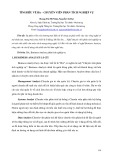1
Exploratory Data Analysis
Learning outcomes
• Understand key elements in exploratory data analysis
(EDA)
• Explain and use common summary statistics for EDA
3
• Plot and explain common graphs and charts for EDA
Motivation
• Before making inferences from data it is essential to
examine all your variables. • To understand your data
• To listen to the data: • to catch mistakes • to see patterns in the data • to find violations of statistical assumptions • to generate hypotheses • …and because if you don’t, you will have trouble later
4
• Why?
Data science process
1. Formulate a question
4. Product
2. Gather data
3. Analyze data
5
Source: Foundational Methodology for Data Science, IBM, 2015
Exploratory data analysis (EDA) focus
• The focus is on the data—its structure, outliers, and
models suggested by the data.
• EDA approach makes use of (and shows) all of the
6
available data. In this sense there is no corresponding loss of information. • Summary statistics • Visualization • Clustering and anomaly detection • Dimensionality reduction
EDA definition
• The EDA is precisely not a set of techniques, but an
• Helps to select the right tool for preprocessing or analysis • Makes use of humans’ abilities to recognize patterns in data
7
attitude/philosophy about how a data analysis should be carried out.
EDA common questions
• What is a typical value? • What is the uncertainty for a typical value? • What is a good distributional fit for a set of numbers? • Does an engineering modification have an effect? • Does a factor have an effect? • What are the most important factors? • Are measurements coming from different laboratories
equivalent?
• What is the best function for relating a response variable to
a set of factor variables?
• What are the best settings for factors? • Can we separate signal from noise in time dependent data? • Can we extract any structure from multivariate data? • Does the data have outliers?
8
EDA is an iterative process
• Repeat...
• Identify and prioritize relevant questions in
decreasing order of importance
9
• Ask questions • Construct graphics to address questions • Inspect “answer” and derive new questions
EDA strategy
• Examine variables one by one, then look at the
relationships among the different variables
• Start with graphs, then add numerical summaries of
specific aspects of the data
10
• Be aware of attribute types • Categorical vs. Numeric
EDA techniques
• scatter plots, character plots, box plots, histograms, probability
plots, residual plots, and mean plots.
• Graphical techniques
11
• Quantitative techniques
Describing univariate data
12
Observations and variables
• Data is an collection of observations
13
• an attribute is thought of as a set of values describing some aspect across all observations, it is called a variable
Types of variables
14
Dimensionality of data sets
• Univariate: Measurement made on one variable per
subject
• Bivariate: Measurement made on two variables per
subject
• Multivariate: Measurement made on many variables
15
per subject
Measures of central tendency
• Measures of Location: estimate a location parameter
for the distribution; i.e., to find a typical or central value that best describes the data.
• Measures of Scale: characterize the spread, or
variability, of a data set. Measures of scale are simply attempts to estimate this variability.
16
• Skewness and Kurtosis
Mean
• To calculate the average value of a set of observations,
17
sum of their values divided by the number of observations:
Median
• The median is the value of the point which has half the data smaller than that point and half the data larger than that point.
• If there are an odd number of observations, find the middle
value
• If there are an even number of observations, find the middle
two values and average them
• Calculation
• Age of participants: 17 19 21 22 23 23 23 38 • Median = (22+23)/2 = 22.5
18
• Example
Mode
• mode is the most commonly reported value for a
• Eg. 3, 4, 5, 6, 7, 7, 7, 8, 8, 9. Mode = 7 • Eg. 3, 4, 5, 6, 7, 7, 7, 8, 8, 8, 9. Mode = {7, 8} = 7.5
19
particular variable
Which location measure is best?
• Mean is best for symmetric distributions without outliers
• Median is useful for skewed distributions or data with
20
outliers
Measure of scale : Variance and standard deviation
• Variance: average of squared deviations of values from
the mean
• Standard Deviation: simply the square root of the
21
variance
Run sequence plot
• displays observed data in a time sequence.
• The run sequence plot can be used to answer the
• Are there any shifts in location? • Are there any shifts in variation? • Are there any outliers?
22
following questions
Bar charts
• a bar chart displays the relative frequencies for the
different values.
• or a chart presents categorical
23
data with rectangular bars with heights or lengths proportional to the values that they represent
Histogram plot
• A histogram is to graphically summarize the distribution
of a univariate data set.
• The histogram can be used to answer the following
• What kind of population distribution do the data come from? • Where are the data located? • How spread out are the data? • Are the data symmetric or skewed? • Are there outliers in the data?
24
questions:
Example of frequency distributions
25
Box plot
26
• Box plot displayed: the lowest value, the lower quartile (Q1), the median (Q2), the upper quartile (Q3), the highest value, and the mean.
Box plot (2)
• The box plot can provide answers to the following
• Is a factor significant? • Does the location differ between subgroups? • Does the variation differ between subgroups? • Are there any outliers?
27
questions:
Skewness
• Skewness is a measure of asymmetry. A distribution, or
data set, is symmetric if it looks the same to the left and right of the center point
28
Mean = median = mode = 3
• Symetrical distribution
Negative, positive skewness
29
Kurtosis
30
• Kurtosis is a measure of whether the data are peaked or flat relative to a normal distribution. data sets with high kurtosis tend to have a distinct peak near the mean, decline rather rapidly, and have heavy tails. Data sets with low kurtosis tend to have a flat top near the mean rather than a sharp peak.
Understanding relationships
31
Scatter plot
• identify whether a relationship exists between two
• two variables are plotted on the x-and y-axis • each point is a single observation.
32
continuous variables measured on the ratio or interval scales
Scatter plot
• Scatter plots can provide answers to the following
• Are variables X and Y related? • Are variables X and Y linearly related? • Are variables X and Y non-linearly related? • Does the variation in Y change depending on X? • Are there outliers?
33
questions:
Scatter plot: No relationship
34
Scatter plot: Strong linear (positive - negative correlation)
35
Scatter plot: Sinusoidal relationship (damped)
36
Scatter plot: variation of Y does not depend on X (homoscedastic)
37
Scatter plot: Outlier
38
Scatterplot matrix
• a collection of scatterplots organized into a grid
(or matrix).
• Each scatterplot shows the relationship between a
39
pair of variables
Lag plot
• For data values Y1, Y2, …, YN, the k-period (or kth) lag
of the value Yi is defined as the data point that occurred k time points before time i. That is Lag𝑘(𝑌𝑖) = 𝑌𝑖−𝑘 For example, Lag1(𝑌2) = 𝑌1 and Lag3(𝑌10) = 𝑌7
• Lag plots can provide answers to the following
• 1. Are the data random? • 2. Is there serial correlation in the data? • 3. What is a suitable model for the data? • 4. Are there outliers in the data?
40
questions:
Lag plot patterns
41
• Random Data
Data with weak autocorrelation
42
Data with moderate autocorrelation
43
Data with high autocorrelation
44
Sinusoidal data
45
Contour plots
• show a three-dimensional surface on a two-
dimensional plane. Contour lines indicate elevations that are the same
• How does Z change as a function of X and Y?
46
• The contour plot is used to answer the question
Demo
47
Identifing and understanding groups Clustering Methods in Exploratory Analysis
48
Motivation
• uncover relationships in the data such as groups of
consumers who buy certain combinations of products
• identify rules from the data • discover observations dissimilar from those in the major
identified groups (possible errors or anomalies)
49
• Decomposing a data set into simpler subsets helps make sense of the entire collection of observations
Clustering
• A way of grouping together data samples that are similar in some way - according to some criteria
50
• A form of unsupervised learning – you generally don’t have examples demonstrating how the data should be grouped together
Can we find things that are close together?
• How do we define close? • How do we group things? • How do we visualize the grouping? • How do we interpret the grouping?
51
• Clustering organizes things that are close into groups
Types of clustering
• Hierarchical clustering
52
• Flat clustering
Hierarchical clustering
• An agglomerative approach • Find closest two things • Put them together • Find next closest
• A defined distance • A merging approach
• Requires
• A tree showing how close things are to each other
(dendrogram)
53
• Produces
Distances
• A method of clustering needs a way to measure how
similar observations are to each other.
• Continuous - Euclidean distance
• Continuous - correlation similarity
• Binary - Manhattan distance
• Pick a distance/similarity that makes sense for the
54
problem
Euclidean distance
55
Manhattan distance
• is the sum of the lengths of the
56
projections of the line segment between the points onto the coordinate axes
Cosine distance
57
Agglomerative Hierarchical Clustering Algorithm
58
Linkage rules
59
AHC result
60
K-mean clustering
• A partitioning approach • Fix a number of clusters • Get “centroids” of each cluster • Assign things to closest centroid • Recalculate centroids
• A defined distance metric • A number of clusters • An initial guess as to cluster centroids
• Requires
• Final estimate of cluster centroids • An assignment of each point to clusters
61
• Produces
62
63
64
65
66
Dimensionality reduction Principal Components Analysis and Singular Value Decomposition
67
Motivation
• Most machine learning and data mining techniques
• Curse of Dimensionality. Irrelevant and redundant features
can “confuse” learners!
• The intrinsic dimension may be small.
may not be effective for high-dimensional data
Curse of dimensionality
• The required number of samples (to achieve the same accuracy) grows exponentionally with the number of variables!
•
=> the classifier’s performance usually will degrade for a
large number of features!
increasing the After a certain point, dimensionality of the problem by adding new features would actually degrade the performance of classifier.
• In practice: number of training examples is fixed!
Motivation
• Dimensionality reduction is an effective approach to
• Visualization: projection of high-dimensional data onto 2D or
3D.
• Data compression: efficient storage and retrieval. • Noise removal: positive effect on query accuracy.
70
downsizing data
Data compression
Reduce data from 2D to 1D
) s e h c n i (
(cm)
Data compression (2)
Reduce data from 2D to 1D
) s e h c n i (
(cm)
Data compression (2)
Reduce data from 3D to 2D
Principal Component Analysis (PCA) problem formulation
Principal Component Analysis (PCA) problem formulation
Reduce from 2-dimension to 1-dimension: Find a direction (a vector ) onto which to project the data so as to minimize the projection error. Reduce from n-dimension to k-dimension: Find vectors onto which to project the data, so as to minimize the projection error.
Demo
76
References
77
Thank you Thank you for your attention! for your Q&A attention!!!
78
Exploratory data analysis in Tableau
79
CitiesExt.csv
• Ten countries with the highest population, bar chart
showing populations
• Pie chart showing relative number of cities with
negative longitude and positive longitude. Label the two slices “west” for west of the Prime Meridian (negative longitude), and “east” for east of the Prime Meridian (positive longitude)
• Is there is any relationship between the latitude of
80
cities in a country (x-axis) and the population of that country (y-axis) (scatter plot)
PlayersExt.csv
• Create a bar chart showing the average number of minutes
played by players in each of the four positions.
• Create a stacked bar chart for teams that played more than 4 games, showing their number of wins, draws, and losses.
• Create a pie chart showing the relative percentage of teams with 0, 1, and 2 red cards. Note: the pie should have three slices.
• Create a scatterplot of players showing passes (y-axis)
versus minutes (x-axis). (Why are there some lines of dots?)
• Create a map of countries colored light to dark blue based
on how many goals their team made (“goalsFor”).
• Create a pie chart showing the relative percentage of
players making <= 0.25 passes per minute, >= 0.5 passes per minute, and between 0.25 and 0.5.
81
Lag plot
• Lag plots can provide answers to the following
• 1. Are the data random? • 2. Is there serial correlation in the data? • 3. What is a suitable model for the data? • 4. Are there outliers in the data?
82
questions:
Block plot
83


























